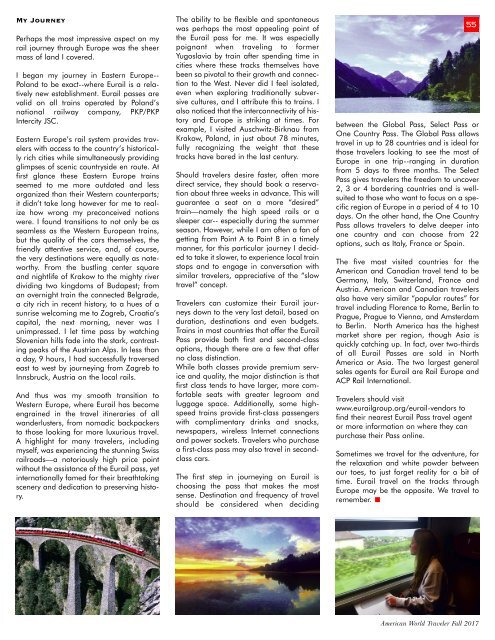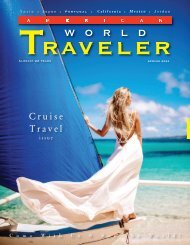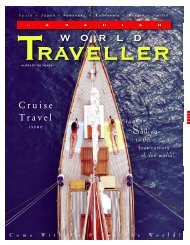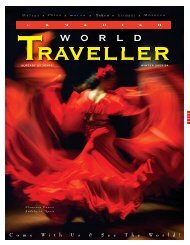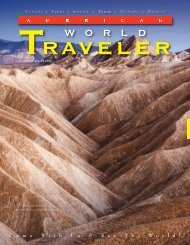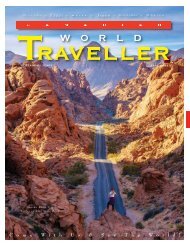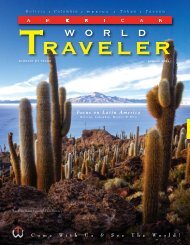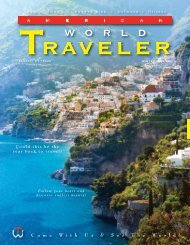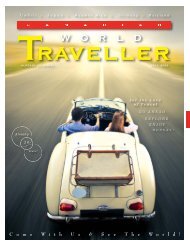American World Traveler Fall 2017 Issue
Now in our 15th year of publishing, American World Traveler explores the culture and history of worldwide destinations, sharing the adventure of discovery with our readers and motivating them to make their travel dreams a reality. Published quarterly, AWT helps sophisticated, independent American travelers choose their next destination by offering a lively blend of intelligent, informative articles and tantalizing photographic images from our World’s best destinations, cruises, accommodations and activities to suit every traveler's taste.
Now in our 15th year of publishing, American World Traveler explores the culture and history of worldwide destinations, sharing the adventure of discovery with our readers and motivating them to make their travel dreams a reality. Published quarterly, AWT helps sophisticated, independent American travelers choose their next destination by offering a lively blend of intelligent, informative articles and tantalizing photographic images from our World’s best destinations, cruises, accommodations and activities to suit every traveler's taste.
You also want an ePaper? Increase the reach of your titles
YUMPU automatically turns print PDFs into web optimized ePapers that Google loves.
My Journey<br />
Perhaps the most impressive aspect on my<br />
rail journey through Europe was the sheer<br />
mass of land I covered.<br />
I began my journey in Eastern Europe--<br />
Poland to be exact--where Eurail is a relatively<br />
new establishment. Eurail passes are<br />
valid on all trains operated by Poland’s<br />
national railway company, PKP/PKP<br />
Intercity JSC.<br />
Eastern Europe’s rail system provides travelers<br />
with access to the country’s historically<br />
rich cities while simultaneously providing<br />
glimpses of scenic countryside en route. At<br />
first glance these Eastern Europe trains<br />
seemed to me more outdated and less<br />
organized than their Western counterparts;<br />
it didn’t take long however for me to realize<br />
how wrong my preconceived notions<br />
were. I found transitions to not only be as<br />
seamless as the Western European trains,<br />
but the quality of the cars themselves, the<br />
friendly attentive service, and, of course,<br />
the very destinations were equally as noteworthy.<br />
From the bustling center square<br />
and nightlife of Krakow to the mighty river<br />
dividing two kingdoms of Budapest; from<br />
an overnight train the connected Belgrade,<br />
a city rich in recent history, to a hues of a<br />
sunrise welcoming me to Zagreb, Croatia’s<br />
capital, the next morning, never was I<br />
unimpressed. I let time pass by watching<br />
Slovenian hills fade into the stark, contrasting<br />
peaks of the Austrian Alps. In less than<br />
a day, 9 hours, I had successfully traversed<br />
east to west by journeying from Zagreb to<br />
Innsbruck, Austria on the local rails.<br />
And thus was my smooth transition to<br />
Western Europe, where Eurail has become<br />
engrained in the travel itineraries of all<br />
wanderlusters, from nomadic backpackers<br />
to those looking for more luxurious travel.<br />
A highlight for many travelers, including<br />
myself, was experiencing the stunning Swiss<br />
railroads—a notoriously high price point<br />
without the assistance of the Eurail pass, yet<br />
internationally famed for their breathtaking<br />
scenery and dedication to preserving history.<br />
The ability to be flexible and spontaneous<br />
was perhaps the most appealing point of<br />
the Eurail pass for me. It was especially<br />
poignant when traveling to former<br />
Yugoslavia by train after spending time in<br />
cities where these tracks themselves have<br />
been so pivotal to their growth and connection<br />
to the West. Never did I feel isolated,<br />
even when exploring traditionally subversive<br />
cultures, and I attribute this to trains. I<br />
also noticed that the interconnectivity of history<br />
and Europe is striking at times. For<br />
example, I visited Auschwitz-Birknau from<br />
Krakow, Poland, in just about 78 minutes,<br />
fully recognizing the weight that these<br />
tracks have bared in the last century.<br />
Should travelers desire faster, often more<br />
direct service, they should book a reservation<br />
about three weeks in advance. This will<br />
guarantee a seat on a more “desired”<br />
train—namely the high speed rails or a<br />
sleeper car-- especially during the summer<br />
season. However, while I am often a fan of<br />
getting from Point A to Point B in a timely<br />
manner, for this particular journey I decided<br />
to take it slower, to experience local train<br />
stops and to engage in conversation with<br />
similar travelers, appreciative of the “slow<br />
travel” concept.<br />
<strong>Traveler</strong>s can customize their Eurail journeys<br />
down to the very last detail, based on<br />
duration, destinations and even budgets.<br />
Trains in most countries that offer the Eurail<br />
Pass provide both first and second-class<br />
options, though there are a few that offer<br />
no class distinction.<br />
While both classes provide premium service<br />
and quality, the major distinction is that<br />
first class tends to have larger, more comfortable<br />
seats with greater legroom and<br />
luggage space. Additionally, some highspeed<br />
trains provide first-class passengers<br />
with complimentary drinks and snacks,<br />
newspapers, wireless Internet connections<br />
and power sockets. <strong>Traveler</strong>s who purchase<br />
a first-class pass may also travel in secondclass<br />
cars.<br />
The first step in journeying on Eurail is<br />
choosing the pass that makes the most<br />
sense. Destination and frequency of travel<br />
should be considered when deciding<br />
55<br />
between the Global Pass, Select Pass or<br />
One Country Pass. The Global Pass allows<br />
travel in up to 28 countries and is ideal for<br />
those travelers looking to see the most of<br />
Europe in one trip--ranging in duration<br />
from 5 days to three months. The Select<br />
Pass gives travelers the freedom to uncover<br />
2, 3 or 4 bordering countries and is wellsuited<br />
to those who want to focus on a specific<br />
region of Europe in a period of 4 to 10<br />
days. On the other hand, the One Country<br />
Pass allows travelers to delve deeper into<br />
one country and can choose from 22<br />
options, such as Italy, France or Spain.<br />
The five most visited countries for the<br />
<strong>American</strong> and Canadian travel tend to be<br />
Germany, Italy, Switzerland, France and<br />
Austria. <strong>American</strong> and Canadian travelers<br />
also have very similar “popular routes” for<br />
travel including Florence to Rome, Berlin to<br />
Prague, Prague to Vienna, and Amsterdam<br />
to Berlin. North America has the highest<br />
market share per region, though Asia is<br />
quickly catching up. In fact, over two-thirds<br />
of all Eurail Passes are sold in North<br />
America or Asia. The two largest general<br />
sales agents for Eurail are Rail Europe and<br />
ACP Rail International.<br />
<strong>Traveler</strong>s should visit<br />
www.eurailgroup.org/eurail-vendors to<br />
find their nearest Eurail Pass travel agent<br />
or more information on where they can<br />
purchase their Pass online.<br />
Sometimes we travel for the adventure, for<br />
the relaxation and white powder between<br />
our toes, to just forget reality for a bit of<br />
time. Eurail travel on the tracks through<br />
Europe may be the opposite. We travel to<br />
remember.<br />
<strong>American</strong> <strong>World</strong> <strong>Traveler</strong> <strong>Fall</strong> <strong>2017</strong>


